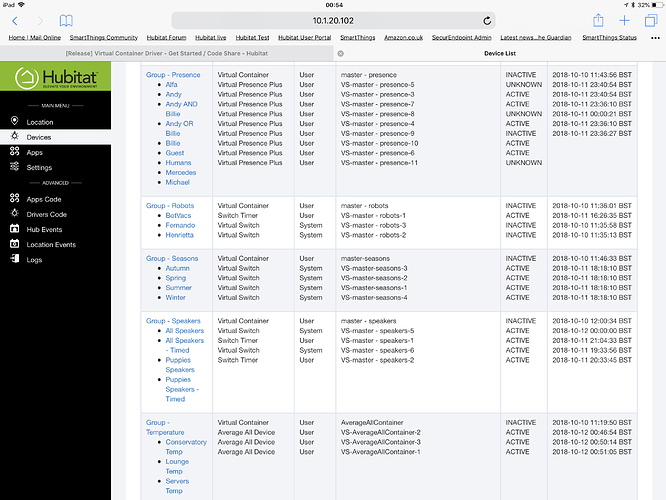It could be that...especially if it's not a stable build (ie beta). There were also weird link related issues with Safari in the past..I thought they were all resolved with HE firmware updates, but this may be related. Let me know if Chrome works and we can have @patrick take a look.
So..I just tried this on my Ipad..not sure if it's the same safari but I noticed something strange. If I tap in the white space next to the child devices, it opens the parent. I have to tap PRECISELY on the child link and then it opens. Try clicking on an actual letter in the child link.
Will do later. I'll let you know. 
It works on chrome for iOS. Must be something with Safari. Good stuff! Thanks!
Safari strikes again.
Glad it was something simple.
Me too for your sake!
I'll remake all of my virtual devices someday soon with this. Thanks.
Child devices can only be accessed via their direct link. The rest of the table row will go to the parent device.
In a future release (probably not the next one) child devices will be their own row.
@stephack
Stephan thank you so much for this!
I was getting a bit bogged down by all the virtual devices I have.
I added a few of my own device drivers to your code and now I have the joy of organisation 
Brilliant!
Thank you again.
Andy
I'm glad folks are finding it useful. In ST it was a lot more complicated with a bunch of quirks that made it work for my various scenarios. That's the main reason why I never shared it over there. For HE I just really simplified the driver and set it to use the the built in drivers to make it even simpler.
I never thought that anyone would add their own custom drivers to this. That's the beauty of these communities...imagination can run wild.
@bravenel is there some way we can add global user variables? Using virtual devices to pass data between apps etc, works, but adding some variables would clean up my code, and rules immensely. Just a thought. Of course, I can also see how triggering off of bool changes, etc could be an issue in the architecture...
There is a way for apps to pass data to each other: use Location Events.
Example:
sendLocationEvent(name: "hsmSetArm", value: value, descriptionText: "Setting HSM arm state")
Another app can subscribe to such events like this:
subscribe(location, "hsmSetArm", armHandler)
Also, you can send data in a map as part of the event, which the handler on the other side could retrieve as JSON data.
Or, if you are referring to within Rule Machine, supporting "variables" is on the wish list, and may or may not be supported in the future.
Update: 10/14/18
- added method customDevices() to act as a template to add up to 10 more custom device drivers
- ValidDeviceTypes state variable created so that all valid types are displayed on container device page for reference
Can you explain how to use the new customDevices() feature a little more in detail? Sorry not sure I understand it completely. Thanks!
You would need to manually edit that section.
Say you want to be able to easily create a custom driver you created called "My Driver" to be included in a Container. You would uncomment the first line and edit accordingly.
def custom1 = [ namespace: "halfrican", driver: "My Driver", ref: "MD"]
Now you can create an instance of your driver in the virtual container. Under the Create Virtual Device button....The NAME would be whatever you wish to call the device. The TYPE would be "MD" because that's what you chose to reference your device type in the custom1 above.
Make sense?
Got ya, thanks
I just have to chime in that this is brilliant. Thank you @stephack
Making it easy to add in our own drivers was very kind....
Yeah. I see @stephack had added custom device types. With my recent discovery with triggering Alexa to speak without a raspberry pi I'll be needing to make a bunch of virtual motion sensors.
Please elaborate.
Haha I'm going to make a clean post about it when I have it working 100% in practice but I've proved it out to work.
Basically taking advantage of SmartThings updated Alexa skill that allows motion sensors to be used as triggers of routines. Also using Other Hub SmartThings Integration:
Basically the flow will be:
Life360 Presence home-> Hubitat rule switches custom motion sensor with switch capability (reset somehow) -> Other SmartThings Hub Integration changes mirrored motion sensor to activated -> Alexa fires pre-configured routine -> routine has Alexa says function.
That simple! lol
OMG @stephack I think you undersold how easy it is to include custom drivers and how automagically you do it!
I was expecting your instructions to tell me to make a new section in the Virtual Container code with the driver that I wanted to instantiate, but you literally only have to have that driver in your Driver Code library and fill in 3 pieces of information in the Virtual Container code...
Now that's smart... Thanks a lot!


